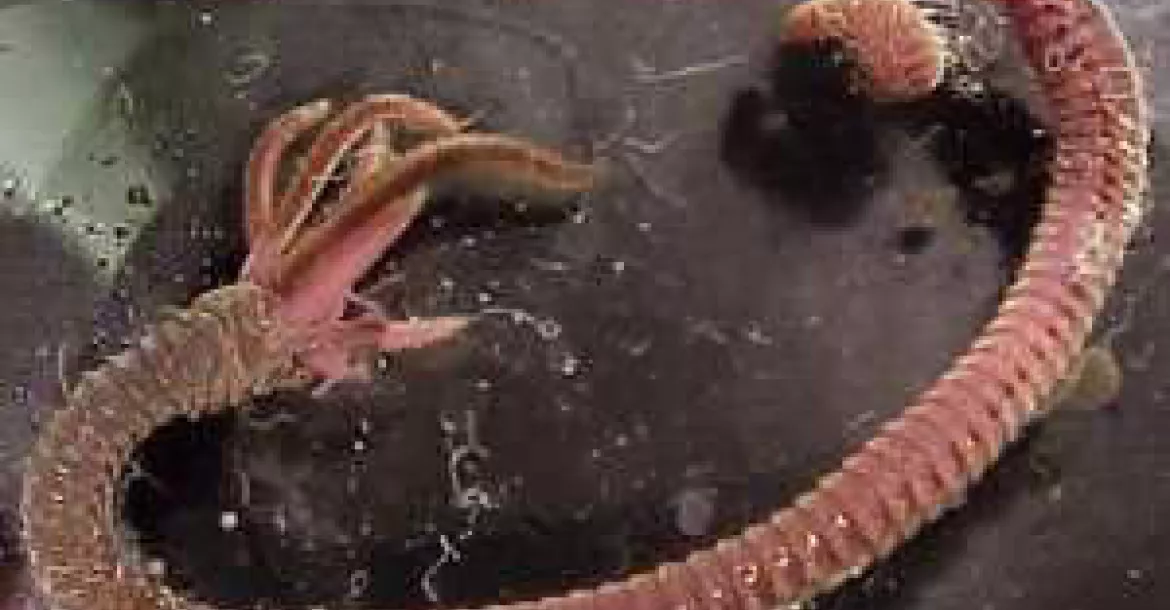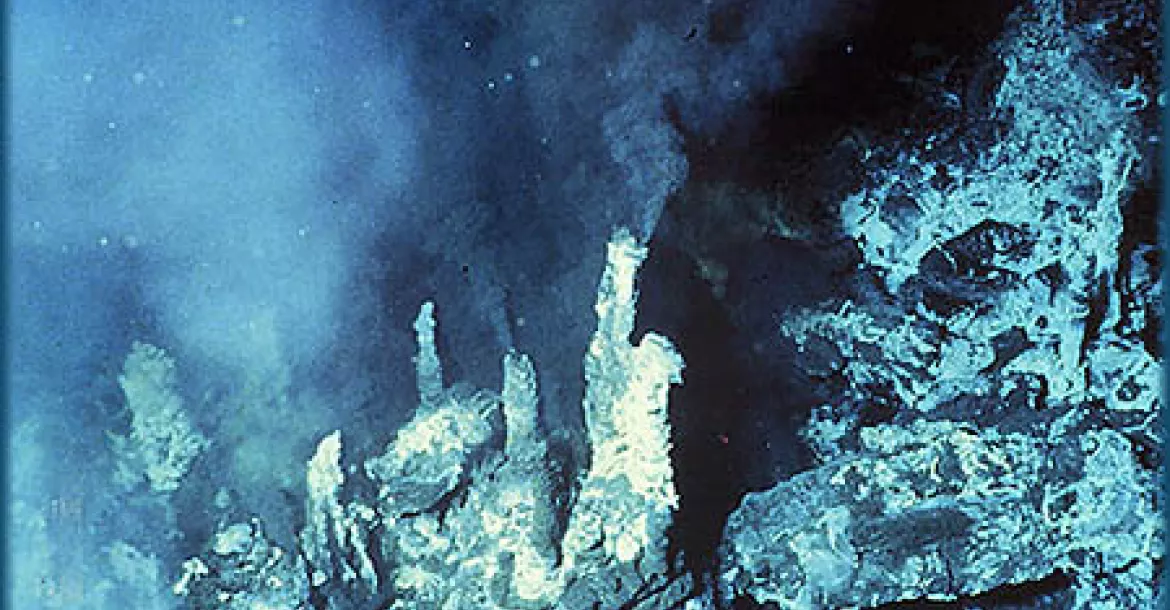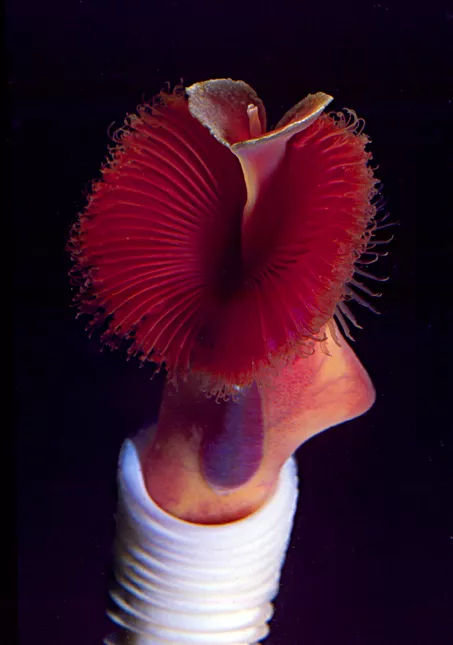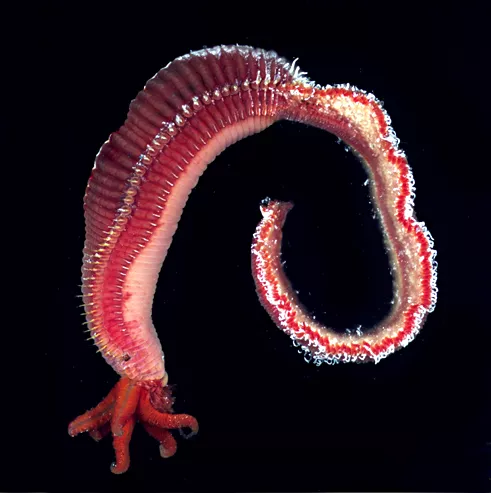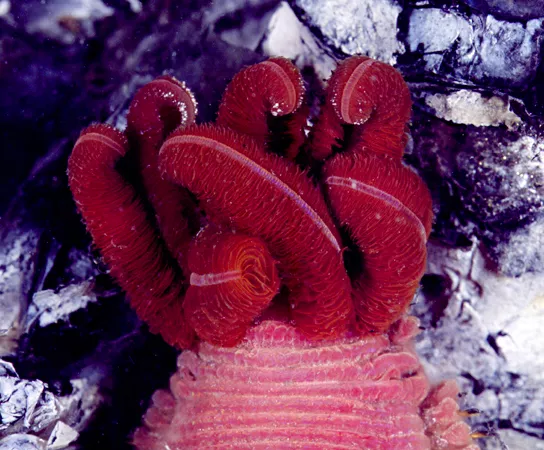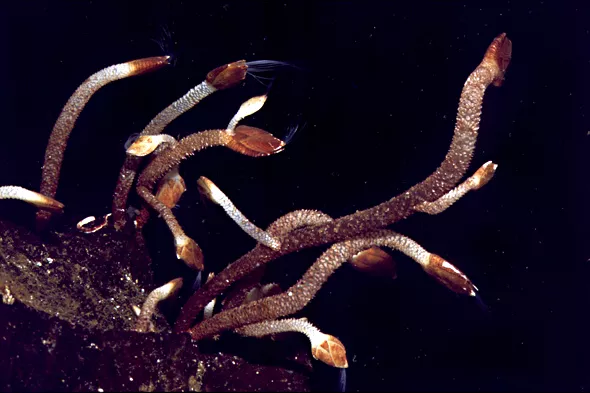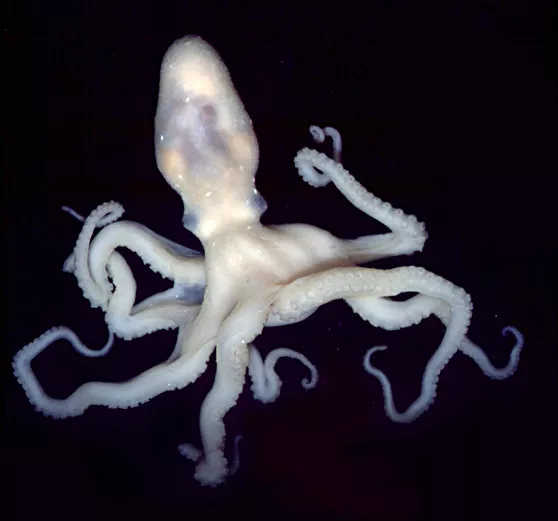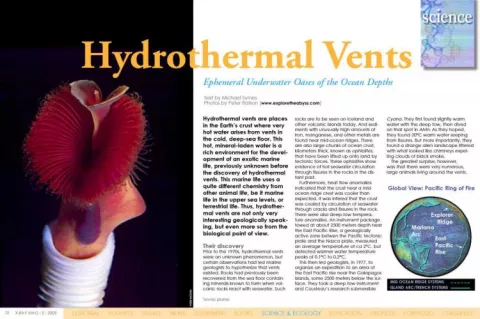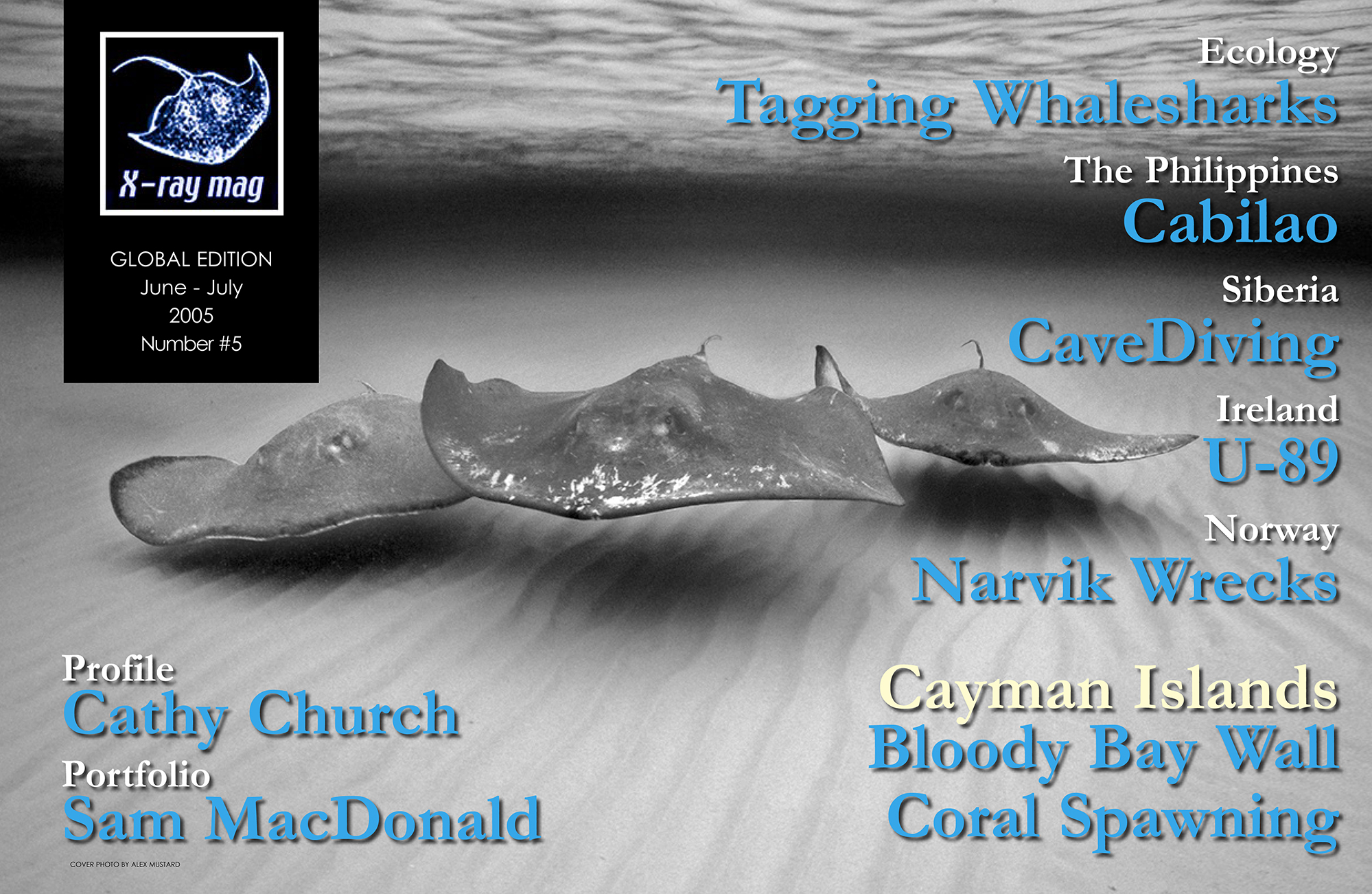Hydrothermal vents are places in the Earth’s crust where very hot water arises from vents in the cold, deep-sea floor. This hot, mineral-laden water is a rich environment for the development of an exotic marine life, previously unknown before the discovery of hydrothermal vents. This marine life uses a quite different chemistry from other animal life, be it marine life in the upper sea levels, or terrestrial life. Thus, hydrothermal vents are not only very interesting geologically speaking, but even more so from the biological point of view.
Factfile
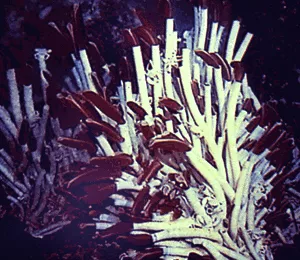
The tubeworm
A particularly remarkable type of vent animal is the tubeworm. These can be 3 or more meters long. They live within a tough, white tube attached to the seafloor near a vent. A red “plume” protrudes from the top of the tube.
This structure contains red haemoglobin, that absorbs oxygen, carbon dioxide, and hydrogen sulfide from the water surrounding the worm. The brown, spongy tissue filling the inside of a tubeworm is packed with symbiotic bacteria - about 10 billion bacteria per gram of tissue.
The bloodstream of the tubeworm transports the absorbed chemicals to the bacteria, which are housed within a special organ called the trophosome.
The bacteria then use these chemicals to grow and to produce organic substances that are absorbed by the worm for food. Having no digestive tract at all, the worm thus depends solely on the bacteria for its nutrition.
Tube worms reproduce by spawning: They release sperm and eggs, which combine in the water to create a new worm. Biologists don’t know how the infant worm acquires its own bacteria. Perhaps the egg comes with a starter set.
At least 5 different species have been discovered.
Their discovery
Prior to the 1970s, hydrothermal vents were an unknown phenomenon, but certain observations had led marine geologists to hypothesize that vents existed. Rocks had previously been recovered from the sea floor containing minerals known to form when volcanic rocks react with seawater. Such rocks are to be seen on Iceland and other volcanic islands today. And sediments with unusually high amounts of iron, manganese, and other metals are found near mid-ocean ridges. There are also large chunks of ocean crust, kilometers thick, known as ophiolites, that have been lifted up onto land by tectonic forces. These ophiolites show evidence of hot seawater circulation through fissures in the rocks in the distant past.
Furthermore, heat flow anomalies indicated that the crust near a mid-ocean ridge crest was cooler than expected. It was infered that the crust was cooled by circulation of seawater through cracks and fissures in the rock. There were also deep-tow temperature anomalies. An instrument package towed at about 2500 meters depth near the East Pacific Rise, a geologically active zone betwen the Pacific tectonic plate and the Nazca plate, measured an average temperature of ca 2°C, but detected warmer water temperature peaks of 0.1°C to 0.2°C.
This then led geologists, in 1977, to organize an expedition to an area of the East Pacific rise near the Galapagos islands, some 2500 meters below the surface. They took a deep tow instrument and Cousteau’s research submersible Cyana. They first found slightly warm water with the deep tow, then dived on that spot in Alvin. As they hoped, they found 20°C warm water seeping from fissures. But more importantly, they found a strange alien landscape littered with what looked like chimneys expelling clouds of black smoke.
The greatest surprise, however, was that there were very numerous, large animals living around the vents. Surrounding these chimneys was a unique type of ecosystem that had never been seen before. These animals turned out to be completely new species, often new Families or Orders, and even one new Phylum. Until then, it had always been assumed that all life on Earth obtained its energy from the sun. Using a process called photosynthesis sunlight is converted into energy by plants which, in turn, provide food for countless species of animals in a complex web of life. But here was a sight that challenged those assumptions. Here was proof for the first time that life could be sustained by the earth itself, totally cut off from the world of sunlight.
Hydrothermal vents and their formation
Hydrothermal vents occur in geologically active regions of the ocean floor where the planet’s crustal tectonic plates are slowly spreading apart thus allowing magma to well up from below to form mountain ranges known as mid-ocean ridges. Vents are usually clustered in fields and normally found at a depth of more than a kilometre. Most have been discovered along the crest of the Mid-Oceanic Ridge, a 74000 kilometre-long chain of mountains that wraps around Earth like the seam on a tennis ball. A few vents have also been found at seamounts, underwater volcanoes that are not located at the intersection of the tectonic crustal plates.
As cracks form in the ocean floor at these spreading centres, seawater seeps a kilometre or two down into the hot rock where it is heated by the intense heat of the magma. As the water is heated to the boiling point, it expands and rises back to the surface, up through the cracks and fissures through which it dropped.
On its way back up, the hot water dissolves minerals and other chemicals from the rock. When it reaches the ocean floor, the water is a rich, chemical soup. Some of the minerals precipitate out of the seawater and harden on the rim of the vent. Over time, the rim of the vent is built up into a tall, chimney-like structure.
These chimneys are formed from dissolved metals that precipitate out when the super-hot vent water meets the surrounding cold deep ocean water. Individual vent openings typically range from less than a centimetre to more than two meters in diameter.
Vent chimneys can grow very rapidly, up to 9 meters in 18 months. During a December 1993 dive to the Phoenix vent field, Alvin accidentally toppled a 10 meter-tall smoker. When the sub returned for a brief visit three months later, the chimney had already grown back 6 meters.
The dark colour of the water spewing forth from these vents has earned them the name black smokers.
As the vent water bursts out into the ocean, its temperature may be as high as 400°C. This water does not boil, however, because it is under so much pressure; for when the pressure on a liquid is increased, its boiling point increases. However, the intense heat is limited to just a small area. Within less than a couple of centimetres of the vent opening, the water temperature drops to 2°C, the ambient temperature of deep seawater.
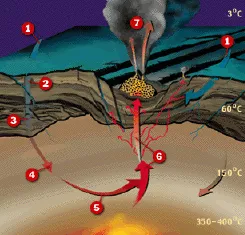
Chemicals in hydrothermal vents
There is a very mineral-rich environment surrounding these vents. The water rising from the vents is acidic, with a pH of about 3.5, and contains up to 0.03% H2S. It contains significant amounts of calcium, potassium, and sodium, together with silicon, barium, rubidium, iron and manganese.
The black smokers are the hottest of the vents. They throw out mostly iron and sulfide, which combine to form the black iron monosulfide. It is this compound which gives the smoker its black colour. There are also so-called white smokers which release cooler water, and which contain amorphous silica mixed with zinc- and iron-sulphide, and calcium- and barium-sulphate. These compounds are white.
However, important and commercially interesting as the chemicals in the vents might be, it is the creatures surrounding the vents that are the most interesting.
Creatures at these oases
Scientists once thought that no living thing could survive the harsh combination of toxic chemicals, high temperatures, high pressures, and total darkness existing at these vents. Similar communities have since been found at several hundred hot spots around the world. Hydrothermal vents are like underwater oases, providing a habitat for many creatures that are not found anywhere else in the ocean. More than 300 new species have been identified since the first vent was discovered in 1977.
These creatures are like nothing else on Earth.
Thickets of giant tube worms, some more than two meters tall, can be seen around the vents. The tail ends of the worms are firmly fixed to the ocean floor, while the red plumes at their heads look like a field of red poppy flowers. When Alvin had been at the same spot less than two years earlier none of these strange creatures had been observed. Measurements at the site have since shown that individual tubeworms can increase in length at a rate of more than 80 cm per year, making them the fastest-growing marine invertebrates.
In addition to the giant tube worms, which have so far been found only in the Pacific, there are Jericho worms, bristle orange worms, small benthic worms living in the mud, and finger-sized, red palm worms that stand upright, topped with fronds. A special class of small worms, called Alvinellids (named after the sub), live on the walls of mineral deposits that form around vents.
Mussels, shrimp, clams, and crabs are abundant at many vents, but these are not the same species we usually eat. The prawn-like shrimps that dominate vents in the mid-Atlantic, for example, have no eyes.
Both clams and mussels reach enormous size near vents. They appear to live about 20 years and attain lengths of 20 to 30 cm. Like the tubeworms they, too, have symbiotic bacteria that live within specially modified gills. Although the clams and mussels do have digestive tracts, it appears that the symbionts provide nearly all of their food.
It is still not fully known how shrimp and other vent creatures can cope with chemical-laden seawater that would kill ordinary shellfish.
While octopuses are at the upper end of the vent’s food chain, bacteria are at the bottom. They are the first organisms to colonize newly formed vents, arriving as if in a blizzard and then settling to form white mats attached to the ocean floor. Bacteria have been found living beneath the ocean’s floor, and it seems likely that they emerge from below when the conditions are right. Most of the creatures that congregate around vents live at temperatures just above freezing.
Thus chemicals are the key to vent life, not heat.
Incredible deep-sea creatures had been known for quite some time, but these animals all depended on the regions above for their sustenance. They feed on small scraps of food and dead animals that fall from above. Here at the vents, though, something entirely different was taking place. These organisms were using another process to get their food directly from the vents themselves.
This process is known as chemosynthesis, with bacteria in the water actually feeding on what would otherwise be a lethal soup of noxious chemicals. Small animals feed on these bacteria, and these small animals again provide food for the larger animals. It is an entire ecosystem, totally separate from the world of light.
It should be noted, though, that not all vent animals have symbionts. Some are scavengers or carnivores that benefit from the rich food supply, for example, crabs and amphipods
Chemosynthesis
Chemosynthesis is analogous to photosynthesis but with a different energy source.
Photosynthesis, which is used by all terrestrial plants, and the great majority of the marine ones too, is exemplified by how phytoplankton produce their food. In this process, carbon dioxide and water react under the energy input of sunlight, with chlorophyll as a catalyst, to produce organic molecules such as sugars and starch, with oxygen as a byproduct.
CO2 + H2O → ‘CH2O’ + O2
where ‘CH2O’ is the basic building block of sugars, lipids, etc.
For the production of a specific compound, sugar, we can write the following process.
6CO2 + 6H2O → C6H12O6 + 6O2
i.e. six molecules of carbon dioxide plus six molecules of water produce one molecule of sugar plus six molecules of oxygen. Here the sugar can be glucose, for example.
However, due to the absence of light energy from the sun to power photosynthesis other energy sources must be used to drive food synthesis. Now, the most prevalent chemical dissolved in vent water is hydrogen sulphide, H2S, which is produced when seawater reacts with sulphate in the rocks below the ocean floor. And it is that which supplies the energy to drive the chemosynthesis, for hydrogen sulphide is a highly reduced molecule, and therefore a great deal of energy can be obtained when it is oxidised.
This ability to oxidize and release the energy in H2S is restricted to certain types of bacteria containing the oxidising enzyme.
Chemosynthesis takes place in two stages, with the first stage being catalysed by bacteria such as Thiomicrospira and Thiothrix.
H2S + 2O2 → SO3- - + chemical energy + H2O
The chemical energy produced here then facilitates the reaction between carbon dioxide and water to produce organic molcules.
CO2 + H2O → ‘CH2O’ + O2
As shown above, symbiotic chemosynthetic bacteria can use hydrogen sulfide as their energy source. However, methane-using symbiotic chemosynthetic bacteria also exist, especially at cold-seeps (see below). There are many varieties of chemosynthetic bacteria. Nearly all use a reduced chemical energy source, using oxygen to oxidize it to produce the energy they need.
Transience
Vent fields are tens of kilometres apart along ridge axes, and most vent fields are probably active only for about 20 years, although some can be active for 100-1000 years. The chimneys eventually become blocked as chemical precipitates plug up the cracks and fissures and flow ceases. The animals near such dead vents also die. However, new vent systems form fairly frequently, as forces of plate tectonics open new cracks and fissures.
Most of the animals that live near vents are sessile, and even animals like crabs can’t move that far. So, how are new vents colonized? How do vent species survive when vents frequently die?
Colonization of new vents
It is not known how tubeworms and other organisms locate new vents for colonization. The vents are small, and they are separated, like islands. Most vent organisms have a free-swimming larval stage. But it is not known whether the larvae float aimlessly or purposely follow clues, such as chemical traces in the water, to find new homes.
Many vent animals produce eggs with large yolk sacs. It seems that their eggs and larvae can survive for a long time, perhaps years. It is thought that the larvae drift with currents along the bottom, which may tend, at least slightly, to flow toward active vents. When the larvae find favourable conditions, they settle to the bottom and grow to adults. However, most die because they fail to find an active vent. When the flow of hot, sulphide-rich water slows to a trickle, death also comes quickly.
Cold Seeps
These are entirely different, geologically, from hydrothermal vents. They occur in situations where sediments are compressed, squeezing out the water between the mineral particles and causing it to seep out of the seafloor. Cold seeps are mentioned here because they have hydrothermal vent-like organisms that use a CH4- or H2S-based energy source.
Animals that don’t live near vents
Some animals normally found in the deep ocean are not found or are rare, near vents. These include sponges and anemones and echinoderms. Perhaps the conditions near the vents (hydrogen sulphide, high temperature, etc.) are harmful to them.
Hydrothermal vents are important sources of knowledge
Interesting as it is in itself, the life surrounding hydrothermal vents is also an important source of knowledge. For example, vent bacteria can withstand higher temperatures than any other organism. That makes them attractive to researchers who are developing heat-stable enzymes for genetic engineering and culturing bacteria designed to break down toxic waste. Also, these bacteria and tubeworms may show the way to the development of new drugs, industrial processes, and other products useful to us all.
Some biologists think that life, in the form of chemosynthetic bacteria, first evolved at vents. One reason is that such deep-sea organisms would have been less affected by the harsh and highly variable conditions on the Earth’s surface, where any photosynthetic organisms would have needed to live.
Certain microorganisms have adapted to thrive on these vents and create rich underwater ecosystems that some scientists believe may represent some of the earliest life forms on Earth. Biologically, hydrothermal vents have a lot to tell us about the origins of life and the conditions in which life can be found, which is important to our continuing search for life elsewhere.
There are many other reasons why scientists want to learn more about hydrothermal vents. For example, these underwater geysers are believed to play an important role in the ocean’s temperature, chemistry, and circulation patterns. Hydrothermal vents are central to the function of the Earth system and the life that is part of it; the vents at ocean ridges are an essential part of the chemical balance of seawater. ■
Published in
-
X-Ray Mag #5
- Read more about X-Ray Mag #5
- Log in to post comments

